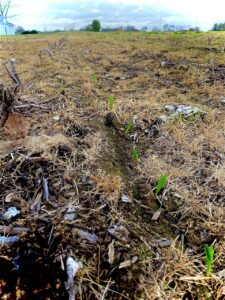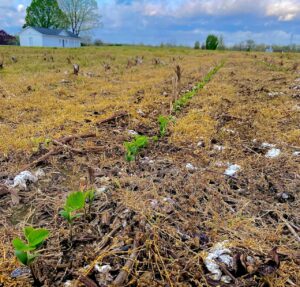As warmer temperatures creep into the forecast each spring, farmers and researchers alike begin to consider just how soon to pull the trigger and put seed into the ground. While these early planting dates may fall slightly outside of what is considered nominal for corn and soybean, certain situations may still provide growers a window of opportunity for early planting.

15 days & 198 GDD’s to Emergence

14 days & 183 GDD’s to Emergence
What defines an “early” planting date with respect to corn and soybean? While the answer varies widely across southern latitudes, it may also vary within states and further within each specific farming operation. In Tennessee, and in particular the western part of our state, any corn or soybean planted before April 15th is usually considered early. Corn is far more sensitive to soil and environmental conditions at planting and shortly thereafter as compared to soybean.
In Jackson at the West Tennessee Research & Education Center, we have established a new corn and soybean planting date study where we are evaluating the agronomic factors and implications of early corn and soybean when a late March – early April planting date is desired. The optimal planting dates for corn and soybean have been widely studied across the midsouth and southeast in recent years. However, we are specifically looking at maximizing economic ROI as a function of planting date. More specifically, if a grower has decided to plant in this window, we aim to answer the question: “should I plant corn or soybean?”
The purpose of this post then is to air out a few thoughts on the agronomics of early planted corn and soybean as we head into April while also looking back through the last half of March.
Growing Degree Days (GDD)
Growing Degree Days as they apply to plant growth and development is not a new concept and one that is frequently used to establish a practical or useable framework for understanding the progression of plant growth throughout the season.
GDD = ((Daily Maximum Air Temp. + Daily Minimum Temp.)/2) – 50
For this formula, we set the daily maximum temperature at 86° F and the daily minimum at 50° F.
If we monitor the accumulation of GDD’s throughout the growing season, we can document the required GDD’s for both plant emergence and the progression from one growth stage to the next. However, there are several factors that can affect the GDD’s required for emergence and plant development especially in the context of early planting dates.
Corn
For corn, possibly the biggest implication of early planting is delayed emergence. GDD’s required for corn emergence may range from 90 – 125 based on research conducted throughout the Midwest; however, several factors may add to this requirement and sway this estimate toward the upper end or higher.
Planting Date
March planted corn may add from as little as 10 to as many as 25 GDD’s for corn emergence (Swan et al., 1987). Corn planted into cool, wet soils can result in not only delayed emergence, but also variability in emergence (non-uniform stands), plant size and vigor, and ultimately result in a disparity in growth stages as the season progresses. A late frost can also (but not always) affect stand uniformity.
Planting Depth
It is well-established that optimal corn planting depth is 1.5 – 2.0”. However, add 15 GDD’s for each inch below 2.0” (Hunter and Kannenberg, 1972).
Surface Residue
This one applies to us in West Tennessee and in all no-till cropping systems. Surface residue (measured in %) can add as few as 5 and as many as 50 GDD’s for emergence (Swan et al., 1987).
Soil Texture
Soil texture also affects required GDD’s for emergence primarily from its effect on water holding capacity and remaining cooler and wetter for longer. Fine soil textures may add 30 – 60 GDD’s for emergence, while coarse soils may detract 30 – 60 GDD’s (Swan et al., 1987).
Soil Moisture
Inadequate soil moisture is not usually an issue in the month of March. However, in conjunction with soil temperature, wet soils can delay emergence and stand uniformity with respect to cool temperatures. Delay planting until soil temperatures are 55° F at a depth of 2.0” at 9:00 am for three consecutive days (Tennessee Corn Quick Facts).
Seed Treatments
Seed treatments may aid or increase in overall emergence and in stand uniformity, but their impact on GDD requirements is not well defined.
Hybrid Characteristics
It is worth noting that not all hybrids will respond equally to the conditions listed above. Hybrids with greater seedling vigor may emerge sooner and more uniformly than others.
Soybean
For soybean, it is worth noting that GDD requirements have not been studied or documented nearly as well as in corn production systems. One potential reason for this may be that soybean is not nearly as sensitive to at-planting conditions as corn. While is documented that soybean requires approximately 130 GDD’s to emergence, similar factors (listed above) and their affect on soybean are not nearly as well documented or understood. For this reason we are documenting GDD’s here in Jackson at the WTREC across multiple planting dates in no-till production.
Final Thoughts
Corn acres in West Tennessee planted in March of this year are likely few and far between. However, for those that did plant corn during this time, allow for delayed emergence. With a uniform stand, yield expectations should still be relatively high as compared to early April corn (94%; Tennessee Corn Quick Facts).
Early planted soybean (late March to early April) have been a frequent topic of conversation with growers I have met with this spring. While 130 GDD’s will take longer to accumulate as compared to soybean planted in later April and May, an indeterminate MG 4 still has high-end yield potential. I would advise budgeting for a harvest aid to get your soybean out at the appropriate time this fall.
Hunter, R.B. and L.W. Kannenberg. 1972. Effects of seed size on emergence, grain yield, and plant in corn. Canadian Journal of Planting Science. 52:252-256.
Swan, J.B., E.C. Schieder, J.F. Moncrieg, W.H. Paulson, and A.E. Peterson. 1987. Estimating corn growth, yield, and grain moisture from air growing degree days and residue cover. Agronomy Journal 79:53-60.

